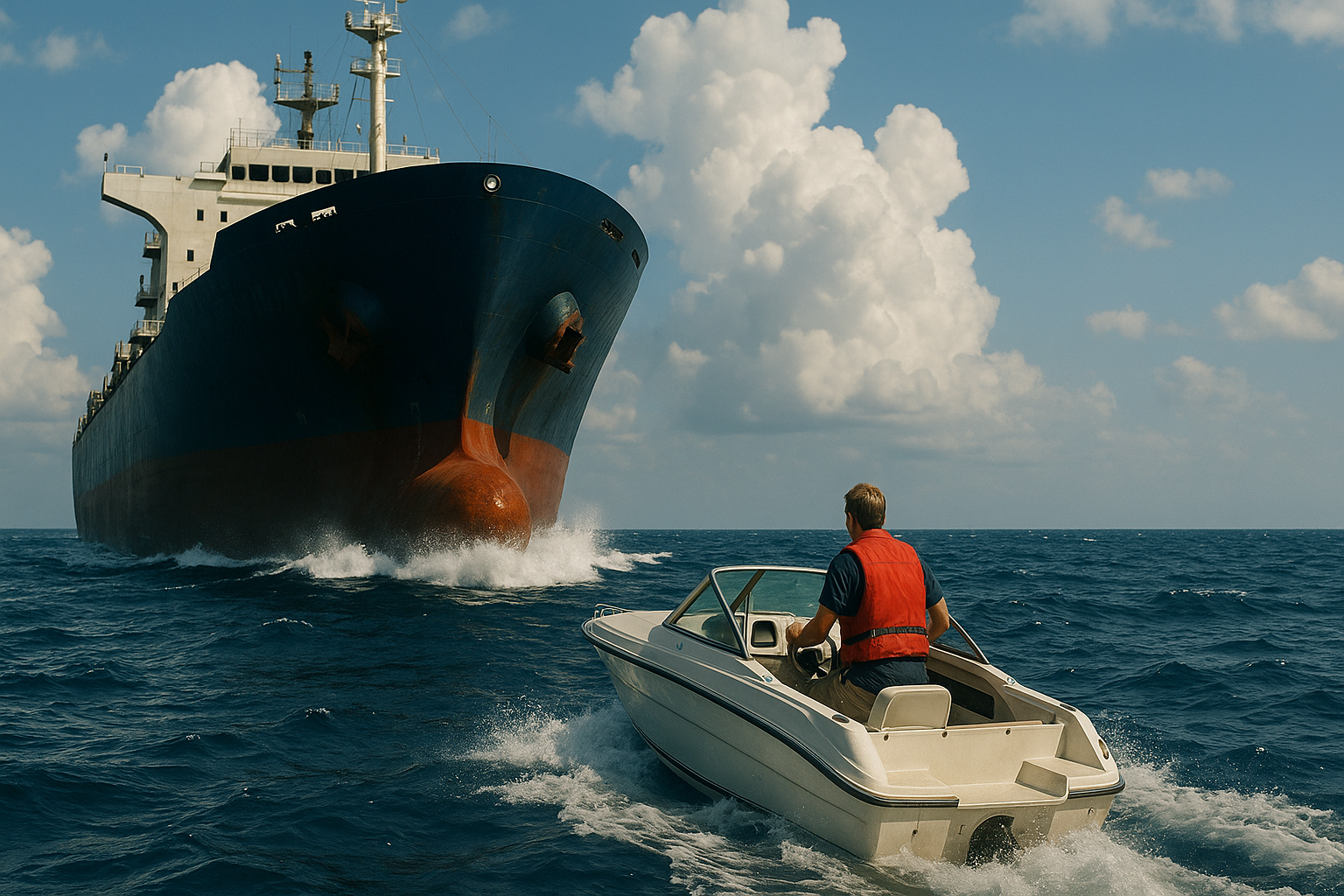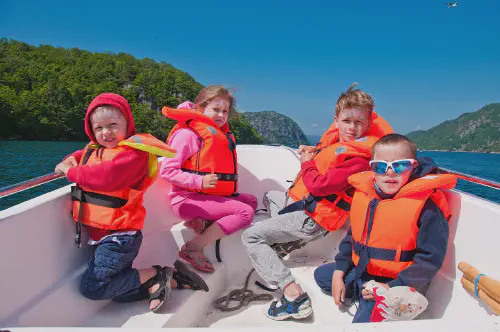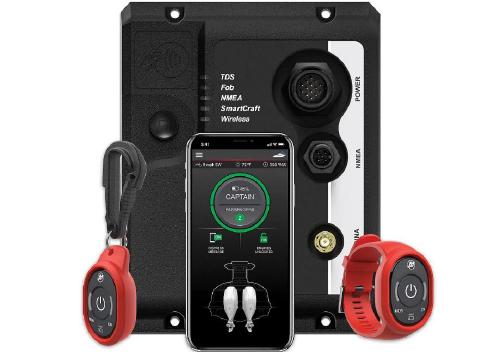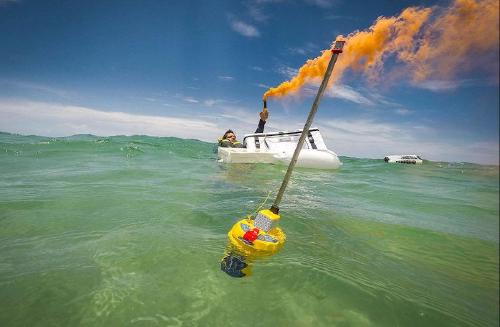Boating season is the perfect time to hit the water and explore the beauty of lakes, rivers, and coastlines. But whether you’re cruising on a personal watercraft, a small sailboat, or a modest powerboat, there’s one thing you must take seriously: navigating safely around large ships.
These massive vessels — from freighters and ferries to cruise ships and tankers — follow specific navigation rules and face major limitations you might not realize. In this article, we’ll walk you through the key things to watch for, including their navigation lights, horn signals, maneuverability challenges, and how to stay safe when sharing the water.
The Size (and Momentum) Matters
Let’s start with the obvious: large ships are really big. We’re talking thousands of tons of steel moving through the water, sometimes at speeds that seem slow but carry incredible momentum. Unlike your nimble runabout, a large ship can’t stop or swerve quickly. In fact, stopping distances for cargo ships can be over a mile even after reversing engines.
So, the golden rule? Never assume they can avoid you. It’s your responsibility to keep clear.
Navigation Lights: Reading a Ship’s Intentions at Night
If you’re boating at night or in low visibility, you’ll be relying heavily on navigation lights. These aren’t just colorful decorations — they tell you where the ship is headed, how big it is, and sometimes what it’s doing.
Here’s a quick breakdown of the most common lights you’ll see on large vessels:
Masthead Light
- Color: White
- Visible from: Front and sides
- What it means: The vessel is powered and underway. One light means a vessel under 50 meters, two vertically stacked lights indicate it’s over 50 meters.
Port Light
- Color: Red
- Visible from: The left (port) side only
- What it tells you: You are looking at the vessel’s left side.
Starboard Light
- Color: Green
- Visible from: The right (starboard) side only
- What it tells you: You’re on the vessel’s right side.
Stern Light
- Color: White
- Visible from: The rear of the vessel
- What it tells you: You’re behind the ship.
Towing Light
- Color: Yellow
- Visible from: Behind
- What it tells you: The vessel is towing — steer well clear!
All-Round Lights
- Color: White, red, or green
- Visible from: All directions
- Used for: Anchored vessels, ships not under command, restricted in maneuverability, or constrained by draft.

If you ever see two red lights in a vertical line, that vessel is not under command — maybe it lost power or steering — so stay well clear.
Horn Signals: The Language of the Sea
Large ships communicate using sound signals, especially when visibility is low or in crowded channels. Here are some basic horn signals you should know:
- 1 short blast: “I am altering my course to starboard (right).”
- 2 short blasts: “I am altering my course to port (left).”
- 3 short blasts: “I am operating astern propulsion.” (going backward)
- 5 short blasts: Warning! “Danger or unclear intentions — get out of the way.”
- 1 prolonged blast (4–6 seconds): Commonly used when approaching blind turns, leaving docks, or in fog.
In fog, large ships may sound one prolonged blast every two minutes to indicate they are underway. If anchored, they’ll sound one short, one prolonged, one short every two minutes.
Why Large Ships Can’t Just “Steer Around You”
One of the most dangerous misconceptions recreational boaters have is assuming big ships can dodge obstacles. Here’s why they can’t:
1. Stopping Distance
As mentioned earlier, it can take a freighter more than a mile to come to a complete stop, even with engines in full reverse.
2. Poor Maneuverability
Turning a large ship isn’t like flicking your tiller. It takes time and planning — and even then, they can’t make tight turns.
3. Draft Limitations
Some ships draw 10 meters (30 feet) or more of water. That means they’re confined to deep channels and can’t simply veer into shallower water to avoid you.
4. Visibility from the Bridge
On most cargo ships, the bridge (where the captain and crew navigate) is set far back. The bow — the front of the ship — can be hundreds of feet away and often blocks their view of small boats directly in front of them. You might be thinking, “They must see me!” but if you’re within that blind zone, you’re invisible.
How to Stay Safe Around Large Ships
1. Stay Out of Shipping Channels
If you see deep-water channels marked on your charts or GPS, steer clear. These are the highways for big ships.
2. Don’t Cross Too Close
Never try to “zip” across the bow of an approaching freighter. It’s moving faster than it looks, and you may be putting yourself directly in harm’s way.
3. Use Your VHF Radio (Channel 16)
If you’re unsure of a ship’s intentions or need to communicate, use your VHF. Hailing them with your boat name, location, and concern is standard practice.
4. Make Predictable Movements
If you’re crossing paths, make a clear, early course change to show your intentions. Erratic movements confuse other vessels.
5. Learn to Identify AIS Targets
Many large ships broadcast their location via AIS (Automatic Identification System), which can be picked up on compatible chartplotters or mobile apps. It’s a fantastic tool for tracking nearby ships — especially in poor visibility.
Bonus: Fun with Binoculars
Want to feel like a pro on the water? Keep a pair of marine binoculars handy and try spotting those nav lights and deciphering what ships are doing. Over time, you’ll become fluent in the “light language” of the sea — and that knowledge makes you a smarter, safer boater.
Final Thoughts
Boating near large ships is totally safe — as long as you understand the rules and stay alert. The water is big enough for all of us, but it’s up to recreational boaters to give the right of way, respect shipping lanes, and navigate responsibly.
When in doubt, remember:
- Assume they can’t see you.
- Assume they can’t stop.
- And always give plenty of space.
So get out there, enjoy the water, and stay sharp when those sea giants roll into view. Happy (and safe) boating!




Use the share button below if you liked it.